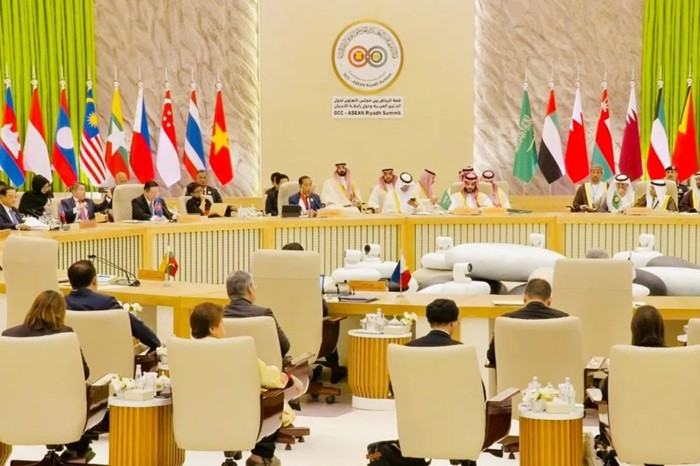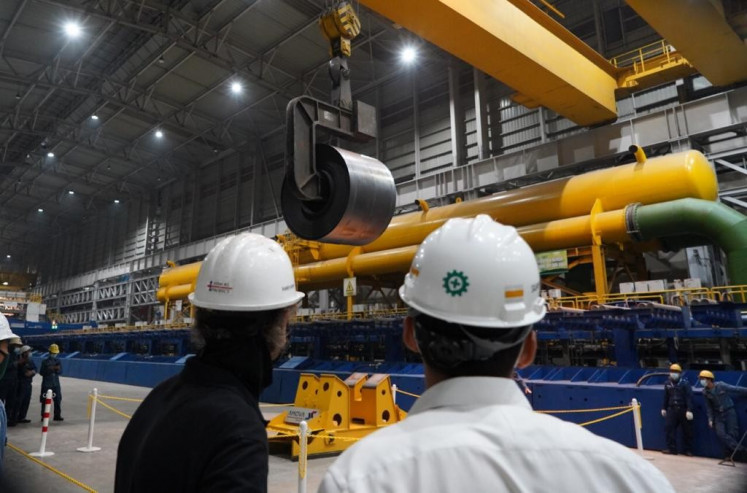Popular Reads
Top Results
Can't find what you're looking for?
View all search resultsPopular Reads
Top Results
Can't find what you're looking for?
View all search resultsMiddle Eastern countries’ interest in Southeast Asia highlights its bright future
The Gulf states may be motivated to look to ASEAN as a model for how to avoid getting stuck in the middle of the heightening global great power competition between China and the US.
Change text size
Gift Premium Articles
to Anyone
F
or many, 2024 is expected to be a lucrative year for Southeast Asia’s tech centers. After a bumpy 2023 that saw many – mostly European – investors withdraw from the region because of global uncertainty sparked by the war in Ukraine, tech start-ups in Malaysia, Singapore and Indonesia are set to be bolstered by fresh cash, especially from Middle Eastern sovereign wealth funds.
Funds from the United Arab Emirates (UAE), Qatar and Saudi Arabia have been the most important drivers of investment into the Southeast Asian tech start-up scene since late last year, seizing investment opportunities that many Western funds, preoccupied with the Ukraine war and the resulting uncertainty in the European neighborhood, have decided to forgo.
According to the Financial Times, between 2022 and 2023, investors from the Gulf have clinched 59 deals in Southeast Asia, a massive increase from the period between 2018 to 2019, when Gulf investors were involved in a mere seven deals.
The Gulf countries’ interest in Southeast Asia is not coincidental: There are many good reasons why investing into the region is a smart move with more than ample growth potential and promising returns. In what think tank and advisory service Asia House has termed “The Middle East pivot to Asia”, Gulf countries have increasingly turned to emerging Asia in an effort to diversify their trade beyond oil, “particularly technology sectors that are vital for the Gulf’s economic diversification and digitalisation” based around “sustainable cooperation” and “synergies in renewables, hydrogen, electric vehicles (EVs), and green construction”.
Consequently, emerging Asia is now fast becoming the most important trade partner for the Gulf states. By 2026, Asia House estimates that the GCC countries’ trade with emerging Asia will surpass the region’s total trade with a basket of advanced economies, including the United States, United Kingdom and Eurozone.
Although China is naturally a major target of Gulf countries’ political and economic ambitions, Asia is a highly diverse and dynamic region. Home to 60 percent of the global population, the region’s many rising economies need fresh cash to continuously fuel growth and innovation – money that the Gulf countries are more than willing to provide. Indeed, investments into Asia, and Southeast Asia in particular, are key to helping the Gulf states achieve their ambitious reform agendas. The success of Saudi Arabia’s “Vision 2030”, the UAE’s “We the UAE 2031” and Dubai’s “D33” hinge much on increasing trade and financial engagement with Asia, particularly emerging Asia over the medium and long term.
Given that both the Gulf and Southeast Asian economies have been seeing strong growth since 2022 despite significant global turbulence, there is reason to believe that this relationship is only going to increase in intensity, according to an HSBC analysis.
Although it has not been immune to the wider economic fallout from the war in Ukraine, Southeast Asia has been much less severely affected than Europe because of fewer direct economic links to either Russia or Ukraine. For example, annual two-way trade between Russia and Indonesia, Thailand, Malaysia, the Philippines and Singapore, accounts for less than 2 percent of their respective total bilateral trade. This has enabled ASEAN countries to navigate the rough geopolitical waters with surprising confidence.
No wonder then that the Gulf states have been zeroing in on ASEAN as an anchor for their regional economic diplomacy efforts. The UAE especially is a driver behind brokering Comprehensive Economic Partnership Agreements (CEPAs) with the leading ASEAN economies, which is leading to deepening trade relations between the Gulf and ASEAN.
Having already secured CEPAs with major markets like India and Indonesia, the UAE is now targeting other ASEAN countries such as Thailand, Malaysia, and Vietnam. This move aims to lower tariffs, remove non-tariff barriers, and enhance its manufacturing and export sectors.
Another important step in boosting Gulf relations with emerging Asia has been the normalization of relations between Saudi Arabia and Thailand. For more than 30 years, following the infamous Blue Diamond Affair in 1989, the two countries had their diplomatic relations frozen. The relationship was restarted with a clean slate in November 2022, when several MOUs on tourism, energy, and renewables were signed following high-level state visits. The restoration of relations between the GCC’s leading economy and ASEAN’s second largest, is a boon to both countries and their wider respective regions.
Geopolitical analysts have pointed out that the Gulf states may be motivated to look to ASEAN as a model for how to avoid getting stuck in the middle of the heightening global great power competition between China and the US.
Jean-Loup Samaan, a senior research fellow at the Middle East Institute, suggests that the Gulf bloc is turning to ASEAN as a paradigm to emulate, studying it as a blueprint for managing competition among major powers, because ASEAN has traditionally been rather successful in not turning into a proxy for any larger power.
The first GCC-ASEAN Summit in October last year made this calculus on both sides abundantly clear. Although ASEAN countries clearly look to GCC investors to reduce their over-reliance on China while avoiding disgruntling the US, the summit notably steered clear of the Sino-American rivalry and geopolitical questions.
With the accession of all GCC states to the Treaty of Amity and Cooperation in Southeast Asia (TAC), ASEAN’s legally binding code for inter-state relations in the region and beyond, the Gulf states have fully arrived in Southeast Asia, providing them with a strong economic and diplomatic foothold in Asia more broadly.
Most importantly, closer GCC-ASEAN cooperation represents a major shift in the balance of power in a world that is moving towards multipolarity at ever greater speeds.
Both regions have already succeeded in growing their global role and weight as independent players on the world stage, and policymakers in the EU, US and elsewhere need to take this fact into account as they seek to navigate an increasingly multipolar world.
***
The writer is global head of public policy at BDO.











